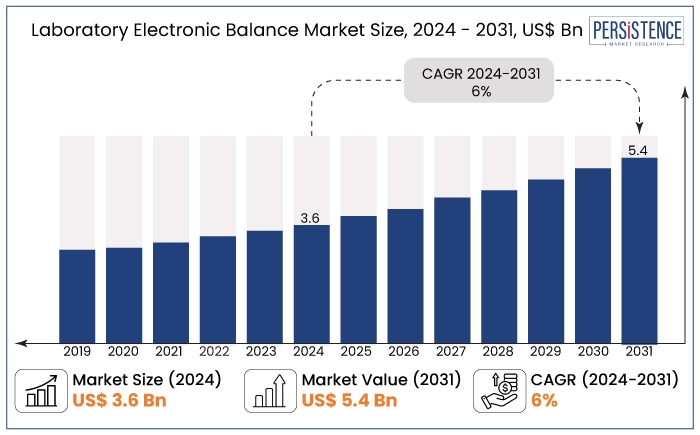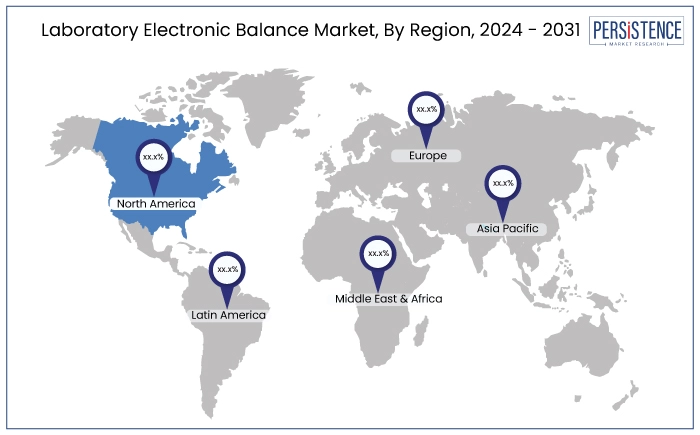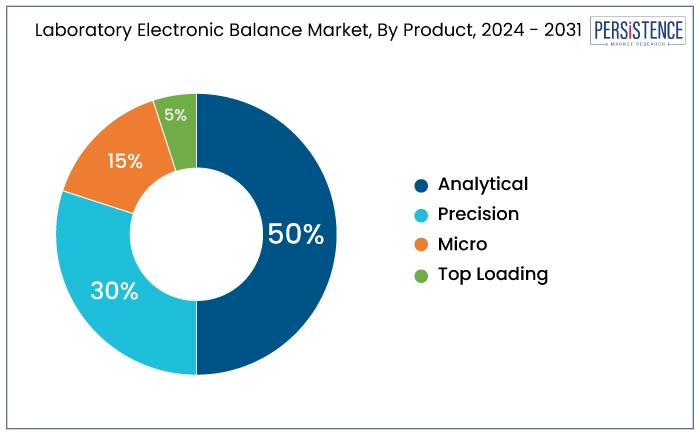ID: PMRREP3189| 191 Pages | 9 Nov 2024 | Format: PDF, Excel, PPT* | Healthcare

The laboratory electronic balance market is estimated to reach a value of US$ 3.6 Bn in 2024 and rise at a CAGR of 6% in the forecast period from 2024 to 2031. It will likely be valued at US$ 5.4 Bn in 2031. An important part of the global laboratory sector, which is worth US$ 84 Bn, the laboratory digital weighing balance industry is anticipated to surge considerably in the next ten years.
Growth is projected to be driven by increasing research investments and rising demand for precise, high-quality instruments in sectors like pharmaceuticals, biotechnology, and environmental sciences. For instance, the UNESCO Institute for Statistics (UIS) found that global investments in research and development reached around US$ 1.7 trillion. Manufacturers are set to focus on strategic opportunity management, targeting local market insights to capture high share.

Key Highlights of the Market
|
Market Attributes |
Key Insights |
|
Laboratory Electronic Balance Market Size (2024E) |
US$ 3.6 Bn |
|
Projected Market Value (2031F) |
US$ 5.4 Bn |
|
Global Market Growth Rate (CAGR 2024 to 2031) |
6% |
|
Historical Market Growth Rate (CAGR 2018 to 2023) |
4.8% |
|
Region |
CAGR through 2031 |
|
North America |
6.1% |
North America is projected to dominate the global market with a CAGR of 6.1% through 2031. This growth is driven by a well-established network of research facilities, pharmaceutical and biotechnology companies, and testing laboratories in the U.S. These require a wide range of high-precision balances.
The ready availability of various balance types, from analytical to microbalances, across multiple price points supports strong growth. Increasing use of e-commerce platforms enables users to easily compare product features, specifications, and reviews. These help streamline the purchasing process for lab managers and researchers. As leading laboratory equipment manufacturers enhance their digital presence, improvements in distribution networks and logistics enable quick delivery and access.

|
Category |
CAGR through 2031 |
|
Capacity Range- 51g to 200 g |
5.8% |
The 51 g to 200 g segment by capacity range is anticipated to dominate the digital weighing scale for laboratory industry. This growth is pushed by the wide application of balances within this range across pharmaceutical, biotechnology, and chemical testing sectors. These require high-precision measurement tools for essential tasks.
Laboratories are also investing in electronic balances that support stringent accuracy for quality control, sample preparation, and regulatory compliance. It will likely make this capacity range particularly valuable. The trend toward unique research methodologies, such as micro-dosing and precise compounding, is further boosting demand for reliable and flexible balances within this range. For instance,
|
Category |
CAGR through 2031 |
|
Product Type- Analytical |
6.3% |
Analytical balances are anticipated to dominate the digital weight scale industry because of their superior accuracy and novel features. Applications requiring high precision measurements like quality control, chemical analysis, and pharmaceutical research, depend on these balances. These are in high demand due to their remarkable reliability in measuring small amounts. It makes them indispensable in labs that value reproducibility and data integrity.
Demand for unique analytical balances is anticipated to increase as labs embrace automation and data-driven methodologies. These balances often have features like integrated software for better user experience, touchless operation, and sophisticated data management capabilities.
The need for analytical balances is further fueled by increasing emphasis on regulatory compliance and quality assurance across a range of industries. Analytical balances will likely remain the foundation of laboratory operations as research gets more intricate and accurate.

Increased awareness of laboratory accuracy and surging demand for precise measurements in various sectors are predicted to fuel the laboratory electronic balance market growth. As laboratories strive for enhanced precision and reliability in their experiments, the need for high-quality electronic balances is becoming more critical.
Surging research and development activities, particularly in pharmaceuticals and biotechnology, presents several opportunities for manufacturers. Unique features, such as high sensitivity, better data management capabilities, and integration with LIMS, are being developed to meet these evolving demands. The trend toward automation in laboratories is also driving the need for efficient balances that can streamline workflows and enhance productivity.
The laboratory electronic balance industry experienced a steady CAGR of 4.8% from 2019 to 2023. Leading manufacturers made significant investments in research and development to enhance their product offerings. They also consistently experimented with materials and design innovations to create unique electronic balance lab equipment. These helped meet the evolving needs of various industries, including pharmaceuticals, biotechnology, and food and beverage.
The market will likely rise at a considerable pace in the forecast period at a CAGR of 6%. This is due to increasing implementation of stringent quality standards by governments of various countries, especially in the U.S. and the U.K. The food and beverage industry is anticipated to demand new laboratory digital weighing machines to comply with quantity norms.
Demand for Electronic Weighing Scales to Skyrocket across High-precision Labs
One of the main factors propelling the market for laboratory electronic balances is the rising need for precise weighing solutions. Demand for superior electronic balances has increased as labs in several industries place a high priority on measurement accuracy.
The food and beverage, biotechnology, and pharmaceutical sectors require cutting-edge digital weighing scales. It is attributed to the urgent need for high precision for quality assurance and legal compliance. By offering thorough documentation of weighing operations, this creative method not only streamlines processes but also guarantees adherence to quality control standards.
Emergence of digital electronic analytical balances with an intuitive user interface is set to make it simpler for lab staff to access a variety of capabilities. These include comprehensive reporting and data analysis tools that make it easier to comply with industry standards.
Need for accurate measurement instruments is expected to remain high among labs aiming to comply with the regulatory requirements set by health authorities. Businesses are projected to invest in high-quality solutions to maintain their quality control procedures and guarantee compliance. The global market for laboratory electronic balances is anticipated to continue rising as a result of this increased emphasis on precision.
Rising Research and Development Activities to Boost Demand
The need for sophisticated laboratory electronic balances is being greatly fueled by growth of research and development activities. It is mainly evident in the pharmaceutical and life sciences industries.
Demand for accurate and dependable weighing equipment grows as researchers work to develop and improve their studies. As precise measurements are essential to the performance of experiments, labs are looking for novel balancing technologies that can cater to their various needs. This helps improve their capacity for research at a broader level.
The need to find creative balance solutions is becoming crucial to advancing different scientific initiatives and maintaining regulatory compliance. Hence, it is anticipated that growing emphasis on research will continue to fuel the need for advanced laboratory balances.
High Cost of Biannual Maintenance to Restrain Demand
The market is severely constrained by the need for routine calibration and maintenance of digital balances for chemistry labs. These balances need to be serviced on a regular basis, which might take time and money, to guarantee correctness and adherence to industry standards.
The need to maintain and calibrate equipment might also be difficult for labs with little funding or staff. For example,
Small-scale labs or facilities may be discouraged from purchasing sophisticated electronic balances due to the requirement for regular maintenance. Instead, they may opt for less expensive, less maintenance-intensive options. As a result, in settings where resources are limited, this is set to impede the uptake of innovative technology and restrict market growth.
Companies Focus on Using Unique Materials to Make Laboratory Digital Scales
The market for digital lab scales is set to rise significantly because of new product development. Manufacturers have the chance to develop innovative products that improve performance and user experience by utilizing cutting-edge materials and technology. Innovations like multifunctional capabilities, user-friendly interfaces, and enhanced durability can help businesses gain a sizable portion of the market. For example,
Manufacturers can better cater to the changing demands of laboratory experts by concentrating on the aforementioned development. It will likely help them establish as industry leaders.
IoT Integration to Play a Key Role in Digital Precision Balance Development
The global market has a lot of potential due to the integration of smart technologies, especially the Internet of Things (IoT). Manufacturers are set to develop devices that provide improved automation, data processing, and monitoring by integrating IoT into laboratory balances.
By connecting to laboratory management systems, smart balances are likely to provide real-time data on weighing procedures, improving operational accuracy and efficiency. To reduce human error and streamline inventory management, a smart laboratory balance can automatically record weights and transfer data to a central system for analysis.
The introduction of Mettler Toledo's XPR Smart Balance, which has a smart connectivity function, enables users to track measures and performance via a dedicated app. By offering thorough documentation of weighing operations, this creative method not only streamlines processes but also guarantees adherence to quality control standards.
Established and emerging businesses compete fiercely in the global electronic precision balance industry as they all work to develop and cater to a range of laboratory requirements. To improve measurement accuracy, durability, and user interface elements, key firms are making significant investments in research and development. For example, to meet the increasing need for accurate and effective weighing solutions, businesses are putting emphasis on cutting-edge technologies like automated calibration and smart networking.
By forming strategic alliances and attending trade exhibitions to present their new products and innovations, local firms are increasing their market presence. Furthermore, new businesses specializing in smart laboratory solutions are taking advantage of the visibility and financial prospects offered by incubators and tech platforms such as Lab Innovations Forum.
By providing crucial networking possibilities, product development resources, and collaborative channels, these platforms help launch cutting-edge laboratory electronic balances onto the market. The focus on sustainability and user-friendly design will likely influence the market's future as the competition heats up.
Recent Industry Developments
The market is projected to reach US$ 5.4 Bn by 2031.
It is an extremely precise weighing instrument for determining the mass of minute items or materials.
Laboratories use analytical balance as it provides maximum weighing performance.
Micro, semi-micro, analytical, and precision are the main types.
METTLER TOLEDO and Adam Equipment are the key manufacturers.
|
Attributes |
Details |
|
Forecast Period |
2024 to 2031 |
|
Historical Data Available for |
2019 to 2023 |
|
Market Analysis |
US$ Billion for Value |
|
Key Regions Covered |
|
|
Key Market Segments Covered |
|
|
Key Companies Profiled in the Report |
|
|
Report Coverage |
|
|
Customization and Pricing |
Available upon request |
By Product Type
By Capacity Range
By End User
By Region
Delivery Timelines
For more information on this report and its delivery timelines please get in touch with our sales team.
About Author